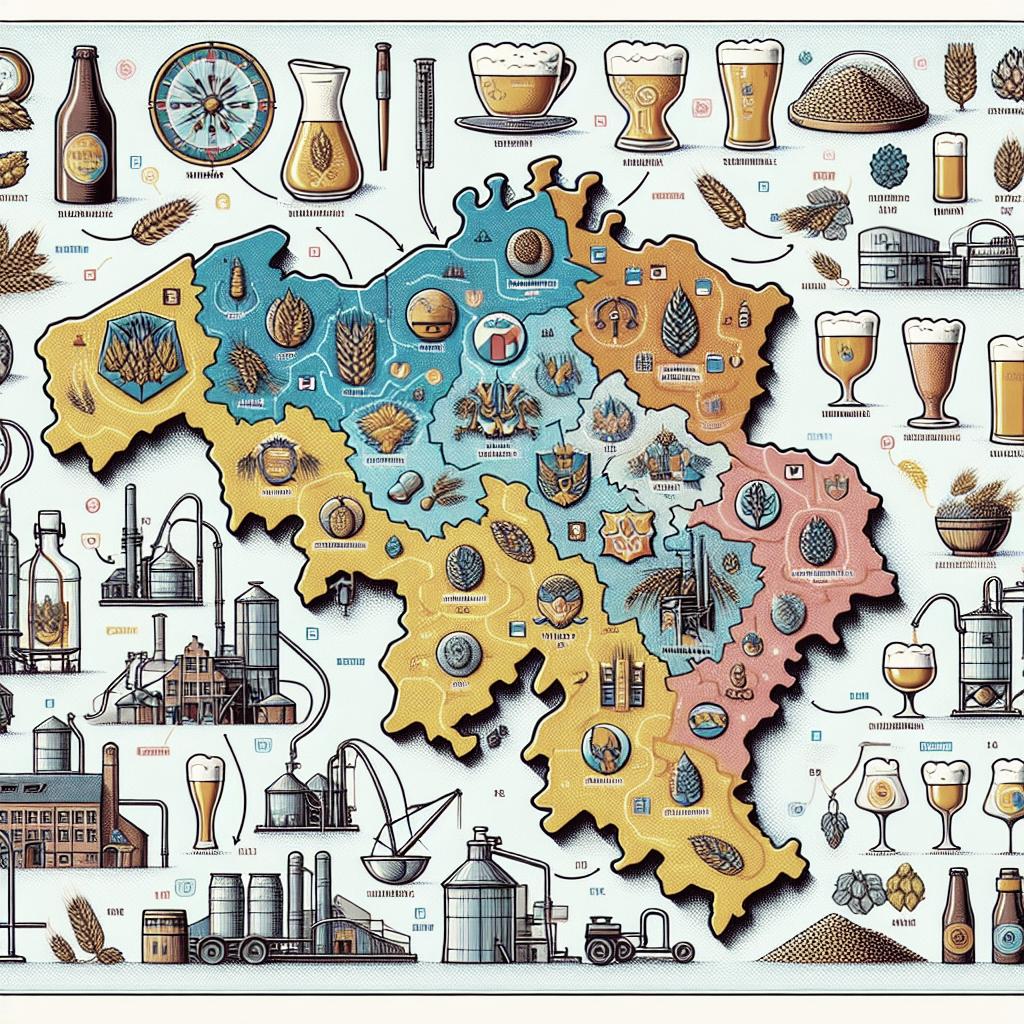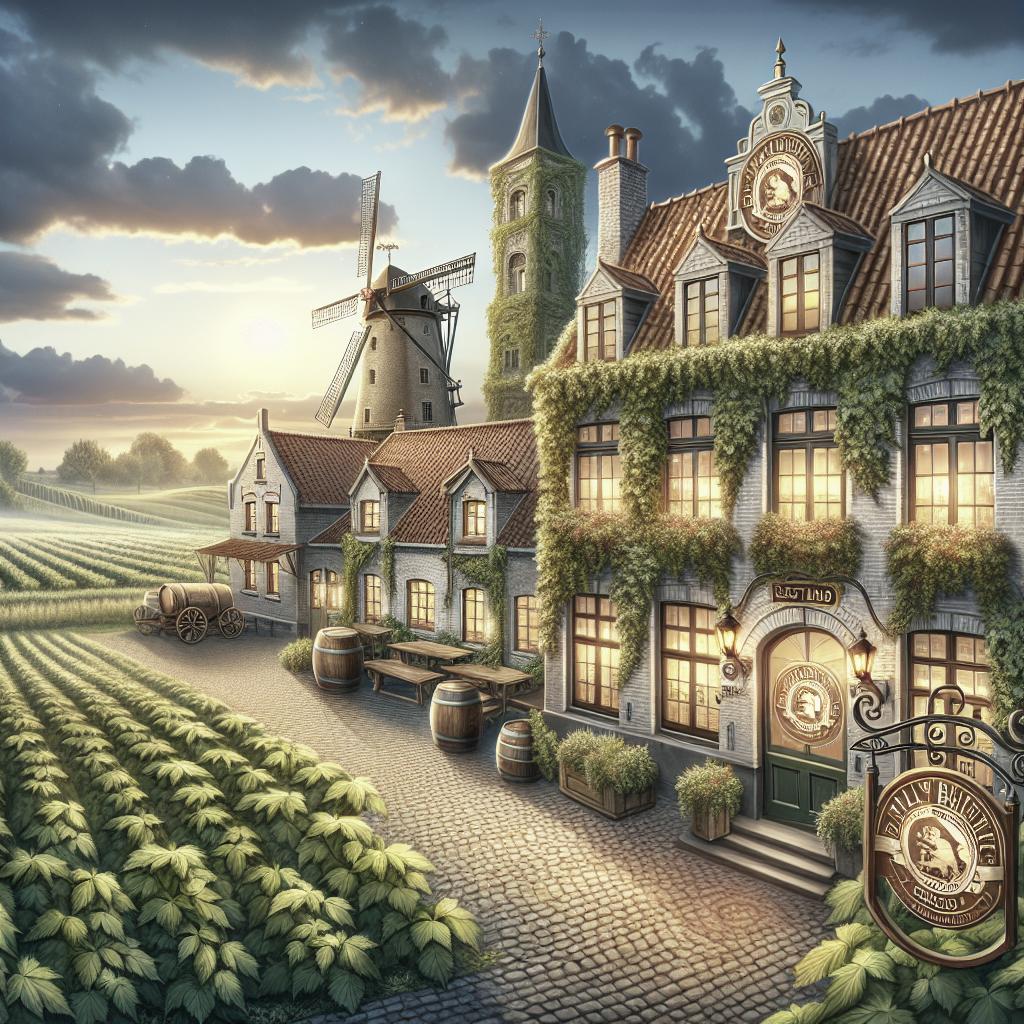“`html
Exploring Regional Differences in Belgian Beer Production
Belgium’s rich beer culture is a tapestry of flavors and histories woven from its diverse brewing landscape. This article delves into the regional distinctions of Belgian beer production, examining how geography, tradition, and innovation play crucial roles. We will explore various beer styles such as Abbey Ales, Dubbel, Quadrupel, Farmhouse Ales, and Sour Ales, among others. Each style has a unique relationship with its locale, offering insight into the country’s brewing heritage and modern adaptations. Understanding these differences not only enhances appreciation for Belgian beers but also provides a deeper look into how regional diversity influences taste and tradition.
Abbey Ales
Abbey Ales, often confused with Trappist beers, are brewed in a monastic tradition, but unlike Trappist ales, the production is not limited to monastic breweries. Abbey Ales can be brewed by commercial brewers under a licensing agreement with an actual abbey or in monastic style without a specific connection to a monastery. Across Belgium, you’ll find Abbey Ales featuring a wide range of flavors, reflecting local preferences and brewing techniques. Generally, they are malty and slightly sweet, with variations reflecting regional ingredients and brewing preferences.
The flavors of Abbey Ales vary regionally, with some breweries emphasizing spice and dark fruit notes while others may focus on lighter, floral aspects. The brewing facilities often incorporate local grains and yeasts, further reinforcing the regional signature of these beers. The result is a rich array of Abbey Ales that showcase the diversity of Belgian brewing, connecting the drinker with the history of the particular region.
Dubbel, Quadrupel, and Belgian Strong Dark Ale
Dubbel, Quadrupel, and Belgian Strong Dark Ales are intertwined with the heart of Belgian brewing tradition. Dubbel, originating from Westmalle Abbey’s revised recipe in the 19th century, has since spread across the country. These beers commonly exhibit rich maltiness with flavors of caramel, dark fruit, and spices. Depending on the region, the balance of these flavors can shift, with some areas favoring bolder fruit notes and others focusing on malty sweetness.
Quadrupels, an evolution of the Dubbel, are known for their robust, complex profile that’s strong enough to be considered a “meal in a glass.” These high-alcohol content ales vary significantly from one region to another, often defined by the specific yeasts used, which contribute unique notes of spice and fruit. Belgian Strong Dark Ales share these complex characteristics, varying with locality to honor traditional recipes or innovate with new ingredients.
Tripel
Tripel ales are a golden staple in Belgian beer, exuding a perfect blend of strength and subtlety. Originating from Westmalle’s innovation in 1931, the Tripel stands out for its light body and strong, spicy character. The unique yeast and sweet malt create fruity, floral aromas that are subject to regional interpretations. In some areas, brewers infuse their Tripel recipes with local spices or honeys to distinguish their offerings, adding depth and regional flare.
As you move through Belgium, you’ll find Tripels that lean toward dryer finishes in the north, embracing a crisper, cleaner taste. Meanwhile, southern regions might favor more rounded, creamy textures. These differences highlight the creativity Belgian brewers have infused into their Tripel production, making every region’s brew an exploration of its local culture and preferred palate.
Farmhouse Ales
Farmhouse Ales in Belgium offer a historic look into the agricultural roots of brewing, where these beers were traditionally brewed during cooler months for consumption in summer. Each region historically crafted its own version using local ingredients and spontaneous fermentation, resulting in a distinct local beer. Today, many Farmhouse Ales preserve this heritage, offering tangy, rustic flavors that reflect their origin.
Often typified by Saison and Biere de Garde, Farmhouse Ales are diverse and vary from dry and earthy with distinct barnyard notes to a slightly sweet, malty finish. The Flemish regions are especially known for maintaining farmhouse brewing traditions, producing complex ales with a perfect marriage of old-world techniques and modern brewing science. These beers exemplify how soil and climate contribute to the unique flavor profiles that define Belgian Farmhouse Ales.
Saison and Bière de Garde
Saison, originating from Wallonia in Southern Belgium, is characterized by its versatility and refreshing finish. Known for its pale, straw color and dry, crisp taste, Saison sometimes incorporates local spices or botanicals, offering a unique twist reflective of the Wallonian countryside. The yeasts used in Saisons often contribute a peppery, fruity complexity, making it a favorite during warmer months.
Bière de Garde hails from just across the border in northern France but shares close ties to Belgian brewing techniques. It features a stronger malt presence and a longer maturation period, which lends it a deeper, richer flavor compared to Saison. Both styles demonstrate the regional variations and shared brewing heritage between Belgium and its neighboring regions, highlighting subtle differences shaped by climate, soil, and tradition.
Other Belgian Ales
The terminology “Belgian Ale” can cover a surprisingly broad category, encompassing many unique and regionally-specific styles. Breweries from all parts of the country differentiate their offerings based on historical recipes and local preferences. This category includes lighter, paler ales as well as those with a darker, stronger character.
Such versatility exemplifies why Belgian beers are known for their complexity and depth. From malts to hops, the influence of the local environment is deeply pronounced in these ales. Esteemed breweries often innovate by cross-blending styles or introducing novel elements, resulting in a colorful spectrum of ale varieties that intrigue and surprise beer enthusiasts around the globe.
Belgian Strong Pale Ale and Belgian Blonde
Belgian Strong Pale Ale is known for its robust profile with an assertive hop character balanced by malt sweetness. Originating from breweries across the country, these ales vary dramatically in taste based on regional ingredients and brewing methods. The balance of hops to malt can shift significantly, creating a diverse array of flavors from one region to another.
Belgian Blonde, by contrast, is often more approachable with a slightly lighter body and less pronounced alcohol presence. Despite its mild persona, Blonde ales still maintain the complexity and distinct character of Belgian brews. Amber-gold hues, subtle fruit notes, and mild spiciness often distinguish these beers, with regional variations offering a spectrum of sweet to dry finishes that cater to local taste preferences.
Belgian Pale Ale
Belgian Pale Ale, a staple that offers balance and drinkability, finds its origins in the region’s response to the popularity of British ales during the early 20th century. Typically less intense than its UK counterparts, this style is known for its subtle caramel sweetness, fruity esters, and hop bitterness, which vary with regional inputs.
The northern regions of Belgium favor pale ales with a more pronounced hop profile, catering to a taste for modern, crisp finishes. Meanwhile, central parts of the country might explore richer malt backbones, delivering a more rounded experience. These ales speak volumes about Belgian adaptability and innovation in embracing external influences while preserving a distinctly local character.
Witbier
Witbier, or Belgian White Ale, captivates with its refreshing and citrusy profile. Prominent in the Flemish region, Witbier is typically brewed with wheat, spices, and orange peel, making it a refreshing choice during warmer weather. The hazy appearance and creamy mouthfeel are its trademarks, stemming from the yeast and brewing methods traditional to this area.
The regional differences in Witbier production are often subtle, primarily influenced by the specific spices used and the proportions thereof. Some might infuse their brews with additional botanicals such as coriander or chamomile, slightly shifting the flavor profile toward either spicy or floral. This regional adaptability in brewing Witbier continues to show Belgium’s innovative spirit in crafting timeless yet evolving beer styles.
Sour Ales
Sour Ales capture the adventurous side of Belgian brewing, pitched with wild yeasts or bacteria to give them a tart, tangy edge. These beers are often barrel-aged, absorbing characters of their vessels and creating distinct local flavor nuances. Famed for their complexity, Sour Ales often act as a natural bridge between beer and wine.
The production method of these ales lends them significant diversity, with some regions preferring light, fruit-forward sourness while others explore deeply earthy, rustic notes. Each region’s microflora will contribute uniquely to the fermenting beer, creating a wide spectrum of sours that reflect their local terroir. Whether through spontaneous fermentation or careful nurturing of yeast cultures, Belgian Sour Ales remain a testament to the country’s ingenuity in brewing.
Lambic and Gueuze
Lambic, one of Belgium’s most renowned sour styles, originates from the Pajottenland region near Brussels. Brewed with up to 40% wheat and left to spontaneously ferment with wild yeasts, Lambics offer intriguing acidity and a dry finish. This method of fermentation imbues the beer with the nuances of its environment, producing flavors ranging from barnyard funk to fruity acidity.
Gueuze, a blend of young and old Lambics, is aged further to develop complex layers and effervescence reminiscent of champagne. These styles encapsulate the epitome of terroir influence, where even slight differences in climate or yeast cultures produce distinct regional interpretations. Lambic and Gueuze highlight the patience and mastery in crafting naturally fermented beers, creating beloved beverages deeply rooted in Belgian heritage.
Flanders Red and Flanders Brown
Flanders Red and Brown Ales stand as the hallmark of Belgian sour brewing, with distinct differences between their regions of origin. Flanders Red, from West Flanders, boasts a complex bouquet of sour cherry, plum, and red wine vinegar due to aging in oak, while Flanders Brown or Oud Bruin hails from East Flanders and showcases a sweeter, maltier profile with milder acidity.
These beers exemplify regional craftsmanship where aging and blending practices are passed down through generations, creating vibrant ales with depth and intrigue. The marriage of time, wood, and yeast imparts flavors that cannot be rushed but instead unfold patiently, allowing brewers to create a palate of tastes reflective of their regions’ history and innovation.
Next Steps
| Beer Style | Key Characteristics | Regional Influence |
|---|---|---|
| Abbey Ales | Malty, slightly sweet | Local grains and yeasts |
| Dubbel, Quadrupel, and Belgian Strong Dark Ale | Caramel, dark fruit, spicy | Regional yeast variations |
| Tripel | Strong, light body, spicy | Local spices, dry vs. creamy |
| Farmhouse Ales | Rustic, tangy | Local climate and soil |
| Saison and Bière de Garde | Straw color, crisp, malty | Wallonia and French influence |
| Belgian Strong Pale Ale and Belgian Blonde | Robust hop, malt balance | Regional ingredient use |
| Belgian Pale Ale | Caramel, fruity, hoppy | Influences from British ales |
| Witbier | Refreshing, citrusy, hazy | Flemish spices and botanicals |
| Sour Ales | Tart, tangy, complex | Wild yeast, regional microflora |
| Lambic and Gueuze | Acidic, dry, champagne-like | Terroir-influenced fermentation |
| Flanders Red and Brown | Sour cherry, plum, vinegar | Oak aging and blending traditions |
“`


